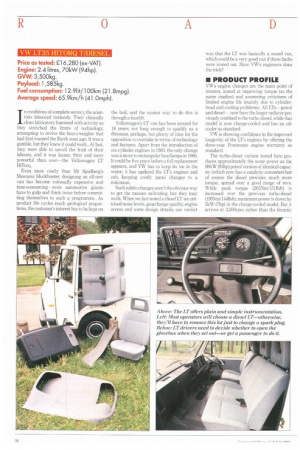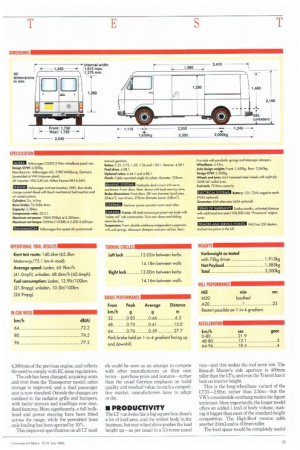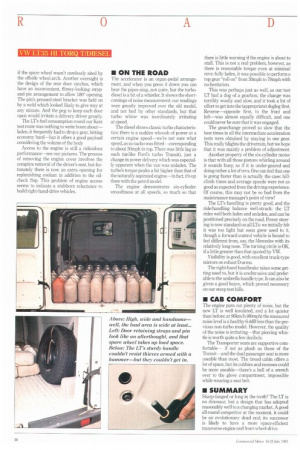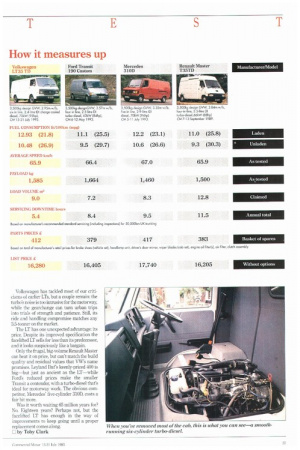I n conditions of complete secrecy, the scientists laboured tirelessly. Their
Page 36

Page 37

Page 38

Page 39

If you've noticed an error in this article please click here to report it so we can fix it.
clinically clean laboratory hummed with activity as they stretched the limits of technology, attempting to revive the heavyweights that had first roamed the Earth eons ago. It was a gamble, but they knew it could work...At last, they were able to unveil the fruit of their labours, and it was leaner, fitter and more powerful than ever—the Volkswagen LT HiTorq.
Even more costly than Mr Spielberg's Mesozoic blockbuster, designing an all-new van has become colossally expensive and time-consuming—even automotive giants have to gulp and think twice before committing themselves to such a programme. As product life cycles reach geological proportions, the customer's interest has to be kept on the boil, and the easiest way to do this is through a facelift.
Volkswagen's LT van has been around for 18 years; not long enough to qualify as a dinosaur, perhaps, but plenty of time for the opposition to overtake in terms of technology and features. Apart from the introduction of six-cylinder engines in 1983, the only change was a move to rectangular headlamps in 1986. It could be five years before a full replacement appears, and VW has to keep its toe in the water; it has updated the LT's engines and cab, keeping costly panel changes to a minimum.
Such subtle changes aren't the obvious way to get the masses salivating, but they may work. When we last tested a diesel LT we criticised noise levels, gearchange quality; engine access and some design details; our verdict was that the LT was basically a sound van, which could be a very good van if these faults were ironed out. Have VW's engineers done the trick?
VWS engine changes are the main point of interest, aimed at improving torque (as the name implies) and answering criticisms of limited engine life (mainly due to cylinderhead and cooling problems). All LTs—petrol and dieselnow have the larger radiator previously confined to the turbo-diesel, while that model is now charge-cooled and has an oilcooler as standard.
VW is showing confidence in the improved longevity of the LT's engines by offering the three-year Powersure engine warranty as standard.
The turbo-diesel variant tested here produces approximately the same power as the 69kW (93hp) petrol version of identical capacity (which now has a catalytic converter) but of course the diesel provides much more torque, spread over a good range of revs. While peak torque (205Nm/1511bft) is increased over the previous turbo-diesel (195Nm/1441bft), maximum power is down by 5kW (7hp) in the charge-cooled model. But it arrives at 3.500rpm rather than the frenetic 4,300rpm of the previous engine, and reflects the need to comply with EC noise regulations.
The cab has been changed, acquiring seats and trim from the Transporter model; cabin storage is improved, and a dual passenger seat is now standard. Outside the changes are confined to the radiator grille and bumpers, with better mirrors and mudflaps now standard features. More significantly, a full bulkhead and power steering have been fitted across the range, while the permitted front axle loading has been uprated by 10%.
This improved specification on all LT mod
els could be seen as an attempt to compete with other manufacturers on their own terms— purchase price and features—rather than the usual German emphasis on build quality and residual value; in such a competitive market, manufacturers have to adapt
The LT van looks like a big square box: there's a lot of load area, and the widest body in the business, but rear-wheel drive pushes the load height up—as per usual in a 3.5-tonne panel
van—and this makes the roof seem low. The Renault Master's side aperture is 400mm taller than the LT's, and even the Transit has it beat on interior height.
This is the long-wheelbase variant of the L135-2.95m, rather than 2.50m—but the VIV's considerable overhang makes the figure irrelevant. More importantly, the longer model offers an added 1.1m3 of body volume, making it bigger than most of the standard-height competition. The High-Roof version adds another 2.6m3 and is 410mm taller.
The load space would be completely useful
if the spare wheel wasn't carelessly sited by the offside wheel-arch. Another oversight is the design of the rear door catches, which have an inconvenient, flimsy-looking strapand-pin arrangement to allow 1800 opening. The pin's pressed-steel bracket was held on by a weld which looked likely to give way at any minute. And the peg to keep each door open would irritate a delivery driver greatly
The LTs fuel consumption round our Kent test route was nothing to write home about— laden, it frequently had to drop a gear, hitting economy hard—but it offers a good payload considering the volume of the body Access to the engine is still a ridiculous performance—see our pictures. The process of removing the engine cover involves the complete removal of the driver's seat, but fortunately there is now an extra opening for replenishing coolant in addition to the oilcheck flap. This problem of engine access seems to indicate a stubborn reluctance to build right-hand-drive vehicles. The accelerator is an organ-pedal arrangement, and when you press it down you can hear the pipes sing...not quite, but the turbodiesel is a bit of a whistler. It shows the shortcomings of noise measurement: our readings were greatly improved over the old model, and not bad by other standards, but that turbo whine was inordinately irritating at speed.
The diesel shows classic turbo characteristics: there is a sudden whoosh of power at a certain engine speed—we're not sure what speed, as no tacho was fitted -corresponding to about 50mph in top. There was little lag as such (unlike Ford's turbo Transit), just a change in power delivery which was especially apparent when the van was unladen. The turbots torque peaks a bit higher than that of the naturally aspirated engine—in fact, it up there with the petrol model.
The engine demonstrates six-cylinder smoothness at all speeds, so much so that there is little warning if the engine is about to stall. This is not a real problem, however, as there is reasonable torque even at minimal revs: fully laden, it was possible to perform a top gear "roll-on" from 30mph to 70mph with no hesitation.
This was perhaps just as well, as our test LT had a dog of a gearbox; the change was terribly woolly and slow, and it took a lot of effort to get into the (appropriate) dogleg first. Reverse—opposite first, to the front and left—was almost equally difficult, and one could never be sure that it was engaged.
The gearchange proved so slow that the best times in all the intermediate acceleration tests were obtained by staying in one gear. This really blights the drivetrain, but we hope that it was mainly a problem of adjustment.
Another property of the six-cylinder motor is that with all those pistons whirling around it sounds busy, as if it is under-geared and doing rather a lot of revs. One can feel that one is going faster than is actually the case: hillclimb times and average speeds were not as good as expected from the driving experience, Of course, this may not be so bad from the maintenance manager's point of view!
The LT's handling is pretty good, and the ride/handling balance well-struck: the LT rides well both laden and unladen, and can be positioned precisely on the road. Power steering is now standard on all LTs: we initially felt it was too light but soon grew used to it, though a forward-control vehicle is bound to feel different from, say, the Mercedes with its relatively long nose. The turning circle is OK, if a little greater than that quoted by VW Visibility is good, with excellent truck-type mirrors on robust D-arms.
The right-hand handbrake takes some getting used to, but it is unobtrusive and preferable to the umbrella-handle type. It can also be given a good heave, which proved necessary on our steep test hills.
The engine puts out plenty of noise, but the new LT is well insulated, and a lot quieter than before: at 961cm/h (60mph) the measured noise level is a healthy 6.4dB less than the previous non-turbo model. However, the quality of the noise is irritating—that piercing whistle is worth quite a few decibels.
The Transporter seats are supportive comfortable-if not as plush as those of the Transit--and the dual passenger seat is more useable than most. The broad cabin offers a lot of space, but its cubbies and recesses could be more useable—there's a hell of a stretch over to the glove compartment, impossible while wearing a seat belt.
Sharp-fanged or long in the tooth? The LT is no dinosaur, but a design that has adapted reasonably well to a changing market. A good all-round competitor at the moment, it could be an evolutionary dead end; its successor is likely to have a more space-efficient transverse engine and front-wheel-drive. Volkswagen has tackled most of our criticisms of earlier LTs, but a couple remain: the turbo's noise is too intrusive for the motorway, while the gearchange can turn urban trips into trials of strength and patience. Still, its ride and handling compromise matches any 3.5-tonner on the market.
The LT has one unexpected advantage: its price. Despite its improved specification the facelifted LT sells for less than its predecessor, and it looks suspiciously like a bargain.
Only the frugal, big-volume Renault Master can beat it on price, but can't match the build quality and residual values that VW's name promises. Leyland Dal's keenly-priced 400 is big-but just as ancient as the LT-while Ford's reduced prices make the smaller Transit a contender, with a turbo-diesel that's ideal for motorway work. The obvious competitor, Mercedes' five-cylinder 310D, costs a fair bit more.
Was it worth waiting 65 million years for? No. Eighteen years? Perhaps not, but the facelifted ur has enough in the way of improvements to keep going until a proper replacement comes along.
by Toby Clark




















































































